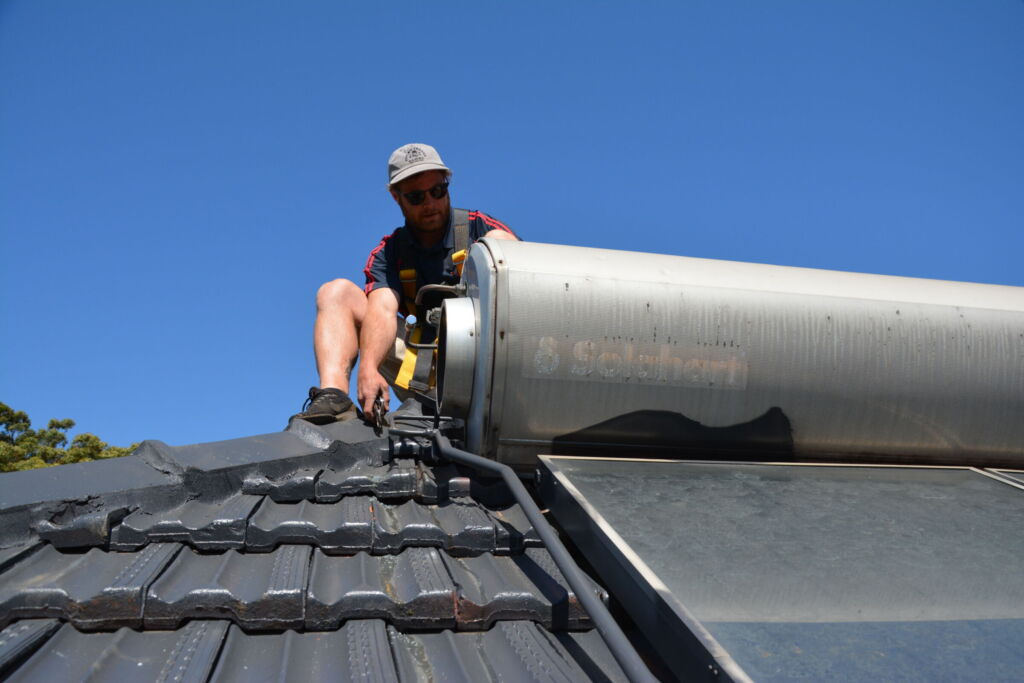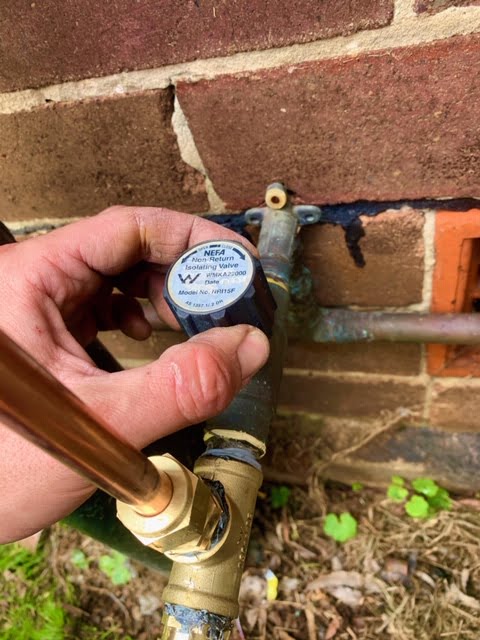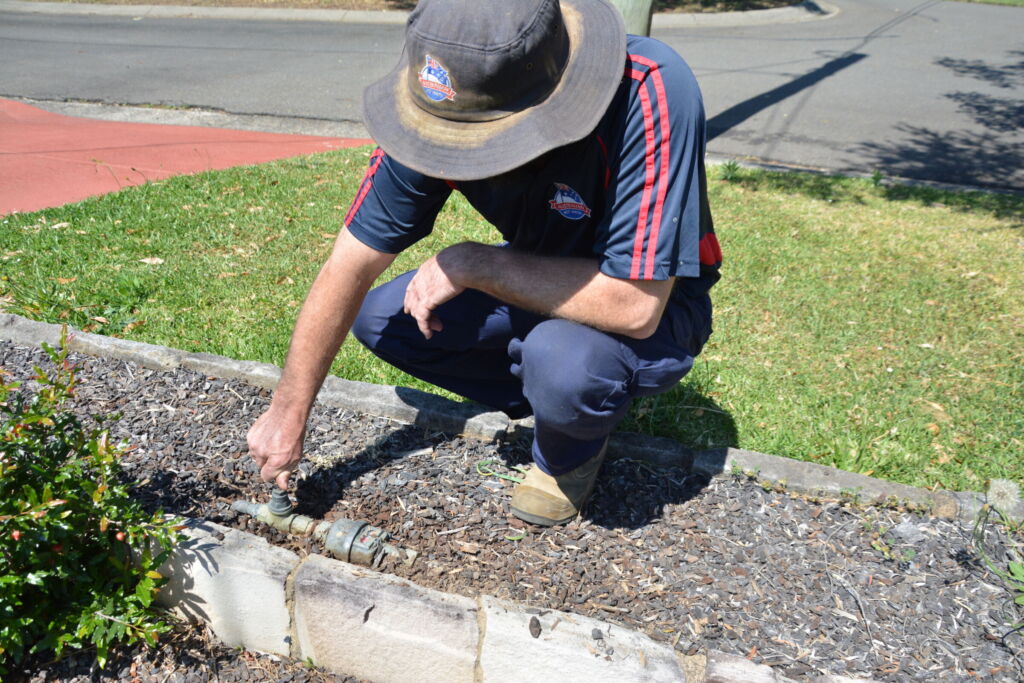Knowing how to turn your hot water system on and off safely is crucial for maintaining your system, achieving energy savings, and preventing potential damage. Whether you have an electric, gas, solar, or heat pump system, this guide provides step-by-step instructions, safety tips, and expert advice for homeowners across Australia.
Key Takeaways
Do not energise an empty storage tank (risk of element damage).
- Never Operate an Empty Tank: Running an electric or gas system without water can cause irreparable damage.
- Electric storage: Confirm tank is full → turn the dedicated breaker/isolator ON → allow 30–90 min to heat.
- Gas storage: Confirm tank full → follow the relight label (pilot then main) → check for a stable flame.
- Instantaneous (gas/electric): Open a hot tap; ensure gas/power ON; these heat on demand. Storage units take 30–90 minutes to reheat; instantaneous units are near-instant.
- Always follow the manufacturer’s guidelines when switching the energy source on.
- Monitor Temperature Settings: Set water temperature to 60°C to prevent scalding while maintaining efficiency.
- Regular Maintenance: Annual servicing ensures efficiency, prevents leaks, and prolongs system life.
Stop if: you smell gas, the breaker trips repeatedly, or the tank may be empty.
Why You Might Need to Turn Your Hot Water System On and Off
There are several reasons you might need to switch your system on or off:
- During Maintenance or Repairs: Prevent water leaks or electrical issues.
- Before going on Holiday: Reduce energy use and avoid possible leaks.
- System Replacement or Upgrades: Safely isolate the system before installation.
- Emergency Situations: Shut off to avoid damage from leaks or faults.
The following are the general steps you will need to take to prepare your hot water heater to be turned on. We will go through the general steps before proceeding to the specifics of gas, electric, instantaneous, and solar models afterwards.
Preparing to Turn On Your Hot Water System
Before activating your system, check the following:
- Power Supply: Ensure it is switched off before any adjustments.
- Gas Supply: Confirm the shut-off valve is off before restarting.
- Water Supply: Make sure cold water is flowing into the system.
- Temperature & Pressure Relief Valve: This safety feature should be functional to prevent overheating or pressure buildup.
- Electrical Connections: All wiring should be secure and meet manufacturer specifications.
Turning on The Water Supply
Step 1 – Turning on the water supply
Ensure the system’s tank is full before turning it on:
- Locate the cold water inlet control valve (usually at the bottom of the heater) and turn it counterclockwise.
- For solar systems, the valve is near the rooftop storage tank. If you’re uncomfortable accessing the roof, turn the water on/off at your home’s main water meter instead.
Step 2 – Check That the Tank is Full
- Turn on a hot tap inside the house.
- Allow fresh water to flush the system until a steady stream (no air sputtering) flows.
- Once steady, turn off the hot tap.
Step 3 – Turn On the Energy Source
- For electric hot water systems, switch on the circuit breaker labelled “Hot Water” or “HWS” on your electrical panel.
- If you can’t locate it, contact a professional for guidance.
Checking if the System is Heating
- Wait a few hours for the water to heat.
- If on off-peak power, large tanks may take overnight.
- Run a hot tap periodically to check if the water is warming.
Find your nearest branch
Step-by-Step: Turning Gas Hot Water Systems Off and On
Older Systems with a Pilot Light
Step 1: Adjust Settings:
- Set the On/Off control to “Pilot.”
- Turn the temperature gauge to the lowest setting.
- Turn the regulator valve off and wait 10 minutes before switching back to “Pilot.”
- If you detect gas smells, turn everything off and call for service.
Step 2: Ignite the Pilot Light:
- Press the pilot button and simultaneously press the piezo ignitor repeatedly.
- Look into the burner area (or use a mirror) to check for a flame.
Step 3: Hold the Pilot Button:
- Continue holding the button for 30 seconds to activate the thermocouple.
- Slowly release the button and ensure the flame stays lit.
- If the flame extinguishes, repeat the process.
Step 4: Turn On the Main Burner:
- Set the On/Off switch to On.
- Adjust the temperature control (standard settings: 50°C without tempering valve, 65°C with one).
- Listen for the system to start heating and run a hot tap to confirm proper heating.
Stop IF: The pilot won’t stay lit. Call our licensed experts and book a service
To turn OFF (gas storage)
- Turn the gas control to OFF. If necessary, close the appliance gas isolation valve.
Step-By-Step: Turning on an Instantaneous Hot Water System
Step 1: Turn off the power and gas:
- Switch off the electrical power point next to the water heater.
- Turn the gas shut-off valve off and wait 5 minutes. If you smell gas, stop and call a professional.




Step 2: Flush the System:
- Open a hot tap for 1–2 minutes to clear any air.
Step 3: Turn Power & Gas Back On:
- Turn the power switch and gas valve back on.
- The system should automatically heat when a hot tap is turned on.
Step 4: Set the Temperature: The standard bathing temperature is 50°C (most systems are pre-set to this internally).
Step 5: If the unit doesn’t start, check the error display or isolation valves.
To turn OFF (instantaneous)
Turn power OFF (and gas OFF for gas models) at the appliance isolation.
Steps for Turning on Electric Hot Water Systems
Step 1: Turn Off the Circuit Breaker.
- Locate the Hot Water Main Switch or HWS and turn off the circuit breaker that supplies the power. Some older buildings can also have just one 415-volt main switch independent of three fuse bases located close to the switch. If you’re not sure of your hot water power switches, then call us for help .
Step 2: Flush the System:
- Turn on the hot tap to ensure to flush out air bubbles and ensure proper water flow through the unit. Run the taps for around 1 or 2 minutes and then turn off.


Step 3: Turn the Power Back On:
- Restore power and run a hot tap to check if the system activates.
- If no hot water flows, contact a professional.
Step 4 Confirm off-peak timers: If on off-peak, heating may start later.
Step 5: Wait 30–90 minutes for hot water (longer for large tanks).
Step 6: If the breaker trips: Switch OFF and book a licensed electrician/plumber.
To turn OFF (electric storage)
Switch the HWS breaker to OFF (and the local isolator if fitted).
Steps for Turning on Solar Hot Water Systems
Given the complexity of different types of solar hot water systems, as well as the relevant gas or electric power source, these steps should be carried out by an expert technician. The following are basic steps that could help in the event of returning from a long holiday, and the system has been turned off or some maintenance has been carried out with the hot water supply to fixtures within the home.
Step 1 – Turn on the water supply
Using the cold water inlet control valve, which is usually located at the bottom of the water heater if the storage tank is on ground level. This can be turned on by twisting the valve generally anti-clockwise. With Solar systems that have tanks on the roof, the valve is generally located up on the roof next to the storage tank. If you are not a person who is comfortable on the roof, then do not attempt this. An alternative is to turn the water on or off at the water meter to the home instead .




Step 2 – Expel air from the system
As with other types of hot water systems, you will need to turn on all of the hot water taps in your home. Next, open the cold water isolation valve fully. Allow the taps to run until water comes freely out of them. When water is flowing freely, this should mean all air has been expelled from the line.
Step 3 – Plug in the solar control unit
Split solar systems have a circulating pump to move water up the the solar collectors. Whether there is gas or electricity supplying the hot water boosting for the storage cylinder, you will need to turn on or plug the solar control unit into the electricity source – generally the power point next to the tank.
Step 4 – Turn the booster on
Electrical solar water heaters have either an electrical booster element or a gas booster. Whether there is gas or electricity supplying the hot water, boosting this will need to be turned on. Some electrical boosters are on a 24-hour power supply and have a switch conveniently located inside the home that may also have an indicator light. In most situations, the booster will be on an off-peak tariff, and the switch will be located at the meter board for the home.
Gas solar water heaters will need the gas supply valve turned on . In the homes that have LPG gas, you will also need to check that the bottle that supplies the gas is also turned on. The modern-day gas boosting solar systems have a continuous flow water heater either mounted to the storage tank of the solar system or on the wall next to the storage tank. These types will need the power supply to the gas system to be turned on for ignition to take place. There are some conventional-style pilot light gas boosters and storage tanks used with ground solar hot water systems. The process of starting a storage gas water heater referenced in this article ( how to ignite an older style gas hot water system ) will be the correct guide in the relighting process of a ground-positioned gas boosted solar storage tank.
If you are experiencing any trouble with your hot water system, contact us today for expert advice and services, including hot water system supply, installation, service and repair.
Find your nearest branch
FAQs About Turning Your Hot Water System On and Off
No. Wait until the tank is fully filled to avoid damage.
1–2 hours for small systems; larger tanks or solar systems may take 3–5 hours. Instantaneous: near-instant once gas/power is on.
Yes, but frequent switching may reduce efficiency.
They require electricity to run the compressor; the water tank must be filled first.
No, pilot or ignition is required for safe operation.
Yes, during holidays or extended absences, turning off prevents energy waste.
Only after filling the tank and isolating the energy source.
Yes. Electric: turn breaker OFF. Gas storage: set to PILOT or OFF per label. Check with your provider for tariff/timer impacts.
Electric storage: Cylindrical tank, no flue, powered via breaker labelled HWS.
Gas storage: Cylindrical tank with flue and a gas control knob.
Instantaneous: Compact wall unit, no large tank, often digital display; gas line visible for gas models.
Expert Advice for Hot Water Systems
If you’re unsure how to safely turn your hot water system on or off, or need installation, maintenance, or repair, Australian Hot Water offers licensed technicians who can:
- Recommend the correct procedure for your system type.
- Safely perform installation or shutdowns.
- Provide maintenance and energy-saving advice.
Get a free consultation or quote today and ensure your hot water system runs safely and efficiently.




